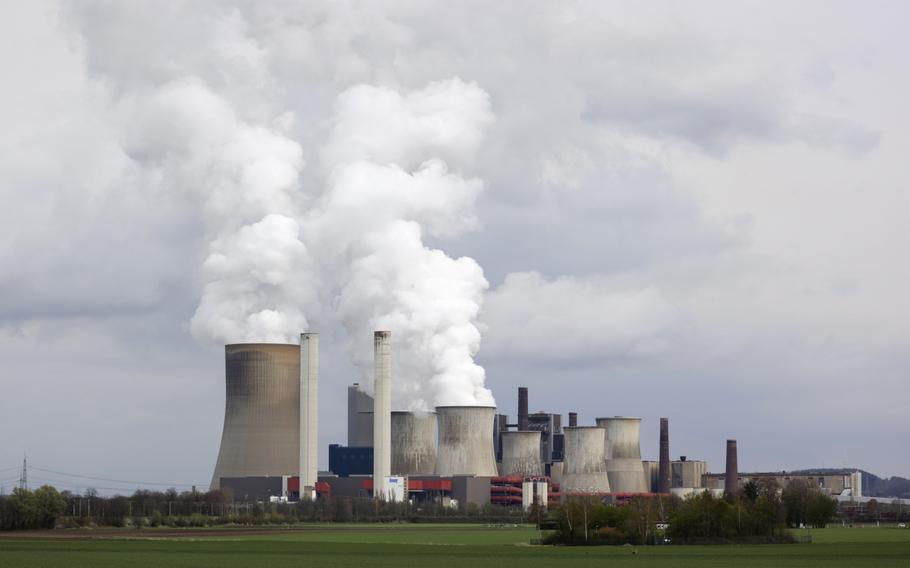
Cooling towers emit vapor at a lignite fueled power station in Bergheim Niederaussem, Germany. (Alex Kraus/Bloomberg)
The European Union’s aim to cut 90% of emissions by 2040 is its most ambitious move yet to try to keep global warming below 1.5C.
The plan recommended by the European Commission would put the world’s largest trading bloc at the forefront of global climate efforts and require a significant overhaul of its economy and trade. Yet it’s likely to face intense debate among member states and the broader public — particularly as the region is lagging on its existing goals.
Here’s everything you need to know the new milestone on the EU’s path to eliminating emissions by mid-century.
The target
The 90% aim recommended by the EU’s executive branch on Tuesday is set to intensify the debate on EU climate policies. The bloc already has two legally binding targets — cutting emissions by 55% this decade (it’s not yet on track) and hitting net zero by mid century. The idea is that the 2040 goal will provide a key strategic way point, but it will be for the next commission to put more flesh on the bones following EU-wide elections in June.
While 90% is preferred by the current commission as the most cost-efficient way to reach net zero, it analyzed three possible reduction goals: 80%, 85-90% and 90-95%. Frontloading efforts comes with advantages, including helping to wean the bloc off fossil fuels faster and leaving it less vulnerable to price shocks. The overall costs, when weighed against inaction, may also be cheaper.
The price tag
That does not mean it will be cheap. The EU estimates it will need to invest about €1.5 trillion ($1.6 trillion) every year between 2031 and 2040. It’s not fully clear where all that money will come from, but a fair amount is already sloshing around the economy, by helping to pay for fossil fuels for example. The most ambitious option analyzed by the EU showed that the region could save around €2.8 trillion in oil, gas and coal expenditure until 2050.
Funding will also come from national governments, but they have differing amounts of fiscal leeway. A key question for the next commission will be whether it decides to undertake fresh borrowing like it did during the height of the COVID-19 crisis. What’s clear is the private sector will have to cough up much of the money.
Technological solutions
A key difference from the 2030 goal is that the 2040 target will aim for a “net” emissions cut. Fossil-fuel use for energy will have been reduced by four fifths, but still play a role. That means carbon capture technology will have to help.
By 2050, as much as 450 million tons of carbon dioxide a year will need to be captured — equivalent to the emissions footprint of Poland and Denmark combined. Global carbon capture and storage capacity was just 50 million tons in 2022, according to BloombergNEF.
A number of additional technologies will be needed, including green hydrogen for industry, batteries to decarbonize the grid and more solar and wind power generators. There are doubts on how well European manufacturers can help meet those needs amid global competition. The quest for clean tech also relies on critical raw materials, a market which is currently dominated by China.
The plan makes reference to nuclear power as a “complement” to renewables. An industry alliance to spur so-called small modular reactors will also be launched.
What to do about agriculture
The EU has already put in place the bulk of the rules it needs to decarbonize its energy, heating and transport sectors, but there’s still a major elephant in the room.
Europe has already gotten a taste of how difficult it is to make agriculture more environmentally friendly, with a plan to restore nature nearly torpedoed by an alliance of farming lobbies and right-of-center political parties in parliament. Commission President Ursula von der Leyen said she will withdraw efforts to halve pesticide use because it became a “symbol of polarization.”
Recently, farmers across Europe have blocked roads and driven tractors into national capitals to protest red tape and falling prices for agricultural commodities. At the same time, business-as-usual would put the bloc’s climate targets firmly out of reach. The 2040 communication provides almost no detail on how agriculture should contribute to the transition after suggestions in previous drafts seen by Bloomberg were removed.
Changing diets and other citizen obligations
Prior references to incentivize dietary shifts among citizens — such as eating less beef, which emits enormous amounts of methane into the atmosphere — were also dropped.
Such omissions highlight the EU’s broader challenge for the next decade. “Easy” decarbonization solutions are already being undertaken, such as the shift to a cleaner power system. The ones that still need to be scaled up might be more difficult, for instance convincing households to insulate homes, buy electric cars, fly less, or shift diets.
Whether the EU can really create a “just” transition — a term that’s repeated ten times throughout the text — remains to be seen.
With assistance from Ewa Krukowska.
©2024 Bloomberg L.P.